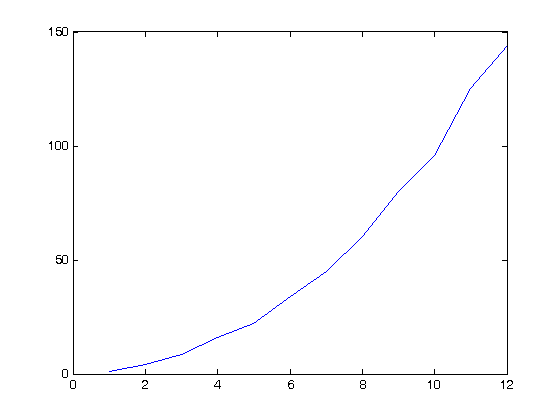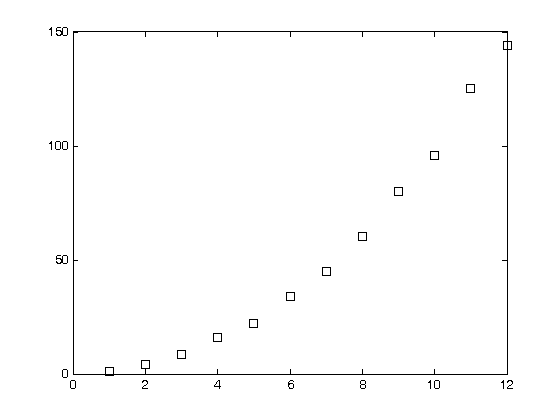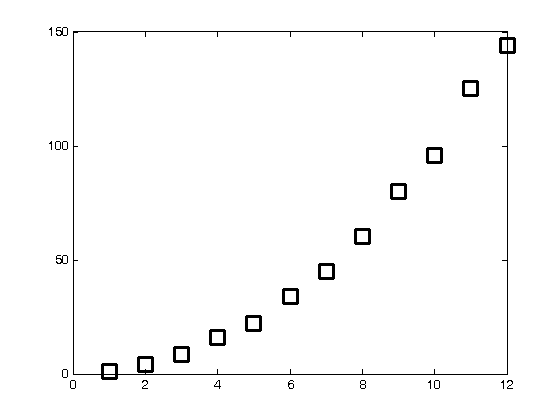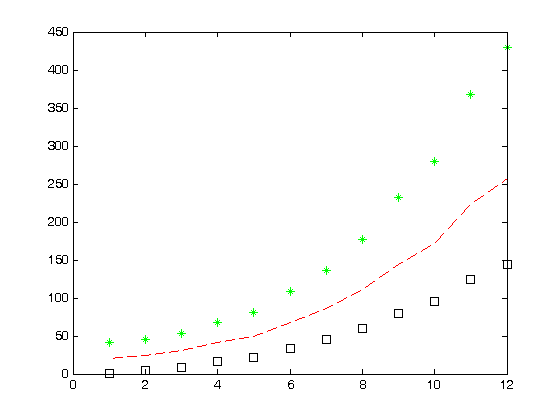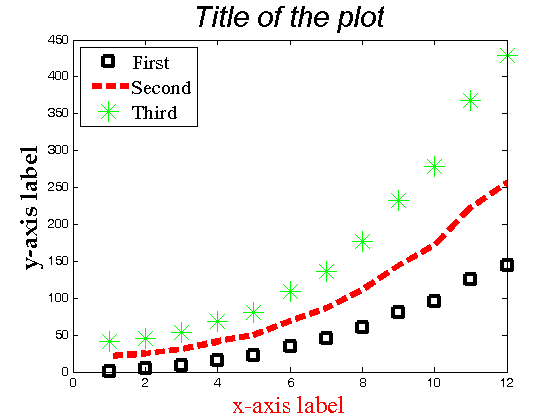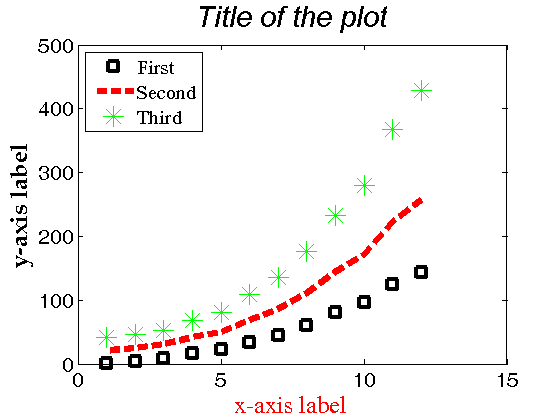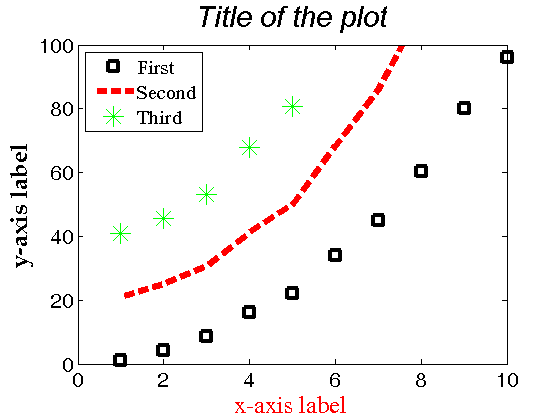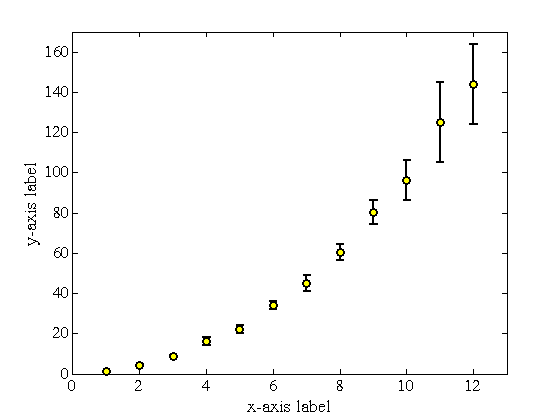% Jake Bobowski % August 17, 2017 % Created using MATLAB R2014a % This tutorial will demonstrate how to create basic plots of data and % functions. clearvars % Below is an example dataset with x and y values. x = [1, 2, 3, 4, 5, 6, 7, 8, 9, 10, 11, 12]; y = [1.02, 4.3, 8.6, 16, 22, 34, 45, 60.2, 80.1, 96, 125, 144]; % Here's the simplest possible plot of y vs x. When you run this script % and new window will appear showing this plot. plot(x, y) % Of course, there are lots of options that can be used to better format % the plot. Before we get to those options, let's clarify an important % point. If we were to execute another plot command, it would overwrite % the plot that was we created just a moment ago. To tell MATLAB that we % want a second plot window to appear, we must first use the command % 'figure()' figure(); % Now let's do some formating. I will not attempt to show you all of the % possible plot options -- you can check the online MATLAB documentation % yourself. I'll just show you some of the basics. % You can make line plots or scatter plots. % scatter plot point types: % o - circle % + - plus sign % * - asterisk % . - point % x - cross % s - square % d - diamond % ^ - up-pointing triangle % v - down-pointing triangle % > - right-pointing triangle % < - left-pointing triangle % p - pentagram % h - hexagram % line plot line types % - solid line (default) % -- dashed line % : dotted line % -. dash-dot line % point/line colours % y - yellow % m - magenta % c - cyan % r - red % g - green % b - blue % w - white % k - black % Here's a point plot using square symbols that are black. plot(x, y, 'ks') % We can use the 'LineWdith' option to adjust the thickness of the line % used to draw the point and we can use 'MarkerSize' to adjust the overall % size of the point. figure(); plot(x, y, 'ks', 'LineWidth', 2.5, 'MarkerSize', 12) % You can put multiple plots in the same plot command and format each of % them differently figure(); plot(x, y, 'ks', x, y.^1.1 + 20, 'r--', x, y.^1.2 + 40, 'g*') % To add axis labels, plot title, and a legend, you can use simple % commands that follow the plot statement. I've included some formating % options just to show how they work. Notice the option in 'legend' % used to position the legend in the top-left corner (I don't know why they % thought northwest was better than topright). figure(); plot(x, y, 'ks', x, y.^1.1 + 20, 'r--', x, y.^1.2 + 40, 'g*') xlabel('x-axis label', 'FontSize', 18, 'FontName', 'Times', 'Color', 'r') ylabel('y-axis label', 'FontSize', 18, 'FontName', 'Palatino', 'fontweight', 'b') title('Title of the plot', 'FontSize', 22, 'FontName', 'Arial', 'FontAngle', 'italic') legend({'First', 'Second', 'Third'}, 'FontSize', 15, 'FontName', 'Times', 'location', 'northwest') % Note that, when you have multiple curves in the same plot statement, you % can't adjust the line thicknesses and point sizes like we did in the % example above. The four lines at the end of this block of code show % way to do it. To use this method, you have to call the plot something % (plot1 is used in the example below). figure(); plot1 = plot(x, y, 'ks', x, y.^1.1 + 20, 'r--', x, y.^1.2 + 40, 'g*'); xlabel('x-axis label', 'FontSize', 18, 'FontName', 'Times', 'Color', 'r') ylabel('y-axis label', 'FontSize', 18, 'FontName', 'Palatino', 'fontweight', 'b') title('Title of the plot', 'FontSize', 22, 'FontName', 'Arial', 'FontAngle', 'italic') legend({'First', 'Second', 'Third'}, 'FontSize', 15, 'FontName', 'Times', 'location', 'northwest') set(plot1(1), 'LineWidth', 3) set(plot1(2), 'LineWidth', 5) set(plot1(1), 'MarkerSize', 10) set(plot1(3), 'MarkerSize', 15) % What a hideous looking plot! % We can also format the tick labels. I don't know why 'gca' is used to % refer to the tick labels. figure(); plot1 = plot(x, y, 'ks', x, y.^1.1 + 20, 'r--', x, y.^1.2 + 40, 'g*'); xlabel('x-axis label', 'FontSize', 18, 'FontName', 'Times', 'Color', 'r') ylabel('y-axis label', 'FontSize', 18, 'FontName', 'Palatino', 'fontweight', 'b') title('Title of the plot', 'FontSize', 22, 'FontName', 'Arial', 'FontAngle', 'italic') legend({'First', 'Second', 'Third'}, 'FontSize', 15, 'FontName', 'Times', 'location', 'northwest') set(plot1(1), 'LineWidth', 3) set(plot1(2), 'LineWidth', 5) set(plot1(1), 'MarkerSize', 10) set(plot1(3), 'MarkerSize', 15) set(gca, 'FontSize', 16, 'FontName', 'Helvetica') % Finally, you can also set the ranges of the x- and y-axes. % Use axis([xmin xmax ymin ymax]) to do this. figure(); plot1 = plot(x, y, 'ks', x, y.^1.1 + 20, 'r--', x, y.^1.2 + 40, 'g*'); xlabel('x-axis label', 'FontSize', 18, 'FontName', 'Times', 'Color', 'r') ylabel('y-axis label', 'FontSize', 18, 'FontName', 'Palatino', 'fontweight', 'b') title('Title of the plot', 'FontSize', 22, 'FontName', 'Arial', 'FontAngle', 'italic') legend({'First', 'Second', 'Third'}, 'FontSize', 15, 'FontName', 'Times', 'location', 'northwest') set(plot1(1), 'LineWidth', 3) set(plot1(2), 'LineWidth', 5) set(plot1(1), 'MarkerSize', 10) set(plot1(3), 'MarkerSize', 15) set(gca, 'FontSize', 16, 'FontName', 'Helvetica') axis([0 10 0 100]) % So far, everything has been done for a simple x vs y plot of data. % In physics will often want to add error bars to our plots. Below are % some error bar values and a plot with error bars. Instead of 'plot', we % use 'errorbar'. I also threw in another option to colour the inside of % the marker yellow. dy = [.3, .3, .5, 2, 2, 2, 4, 4, 6, 10, 20, 20]; figure(); errorbar(x, y, dy, 'ko', 'MarkerSize', 6, 'LineWidth', 1.5, 'MarkerFaceColor', 'y') xlabel('x-axis label', 'FontSize', 14, 'FontName', 'Times') ylabel('y-axis label', 'FontSize', 14, 'FontName', 'Times') set(gca, 'FontSize', 12, 'FontName', 'Times') axis([0 13 0 170]) % I can't resist showing one more option. Suppose you wanted to add text % to you plot, maybe somewhere where there's a lot of white space. You can % use text(x-coordinate, y-coordinate, 'text') to do just that. figure(); errorbar(x, y, dy, 'ko', 'MarkerSize', 6, 'LineWidth', 1.5, 'MarkerFaceColor', 'y') xlabel('x-axis label', 'FontSize', 14, 'FontName', 'Times') ylabel('y-axis label', 'FontSize', 14, 'FontName', 'Times') set(gca, 'FontSize', 12, 'FontName', 'Times') axis([0 13 0 170]) text(2, 125, 'some text', 'FontSize', 18, 'FontName', 'Times') % What if the text you wanted to add is some complicated symbollic % expression? Those of you that a familiar with entering in equations in % LaTeX will love this. MATLAB has a LaTeX interpreter. See the last line % in the block of code below to see how to use it. Note that you can use % the LaTaX interpreter in axis labels and plot titles too. figure(); formattedPlot = errorbar(x, y, dy, 'ko', 'MarkerSize', 6, 'LineWidth', 1.5, 'MarkerFaceColor', 'y'); xlabel('x-axis label', 'FontSize', 14, 'FontName', 'Times') ylabel('y-axis label', 'FontSize', 14, 'FontName', 'Times') set(gca, 'FontSize', 12, 'FontName', 'Times') axis([0 13 0 170]) text(2, 125, '$p_n(\mathbf{k})=\frac{e^{-n\hbar\omega(k)/k_\mathrm{B}T}}{Z(\mathbf{k})}$', 'Interpreter', 'LaTeX', 'FontSize', 18, 'FontName', 'Times') % The LaTeX text generated in the pop-up window that MATLAB produces will % look terrible. However, if you export the figure to an .eps format % (encapsulate postscript) it will look sharp! saveas(formattedPlot, 'formattedPlot.eps', 'epsc'); % Maybe you think that the .eps file format is inconvenient (it's not, % btw). Never fear because one fine member of the MATLAB community has % created a MATLAB function to convert the eps file to a pdf while % maintaining good resolution. The MATLAB command below initiates the % conversion. For this to work, you must have eps2pdf.m and the .eps file % in the same directory as the script that you're working in. You can % download eps2pdf.m from the same website that you found this tutorial. eps2pdf 'formattedPlot.eps'; % It is also possible to save the plot as a jpg (or tiff or bmp or png). % However, the result is NOT good. First, the LaTeX expression will look % terrible. Even tick labels and axis labels will look bad with even a % modest amount of zooming in. The eps format, however, is a vector % graphics format so that image still looks great even at very high levels % of zoom. Here's how the jpg is created if you need to see it for yourself. saveas(formattedPlot, 'formattedPlot.jpg');
pdf successfully created
